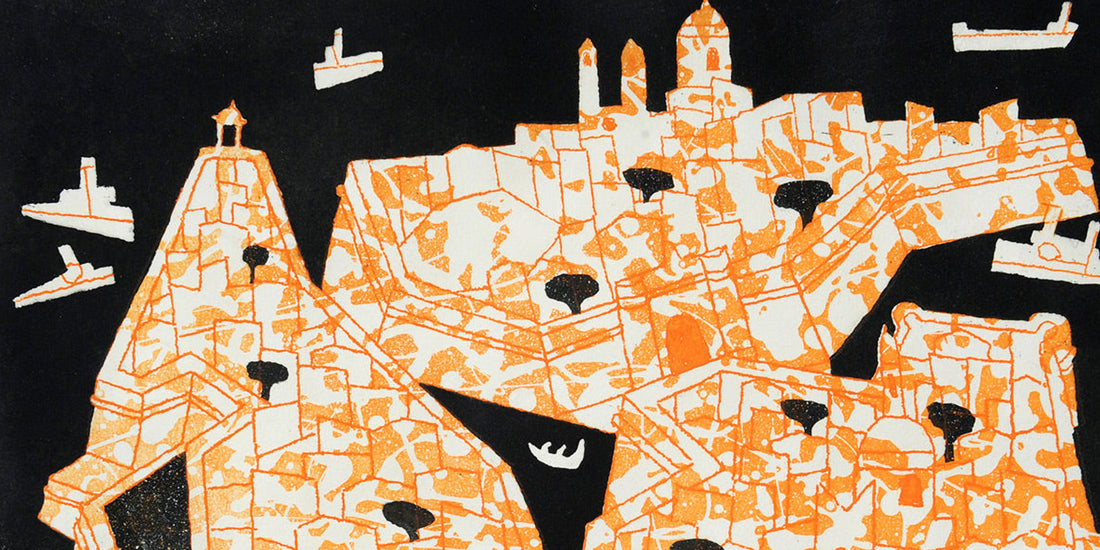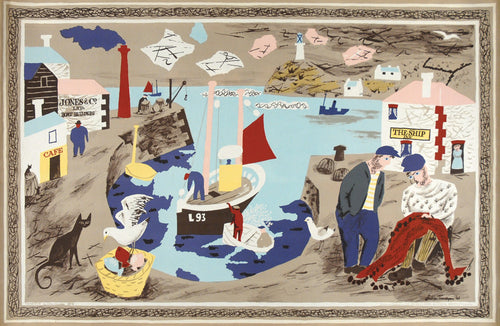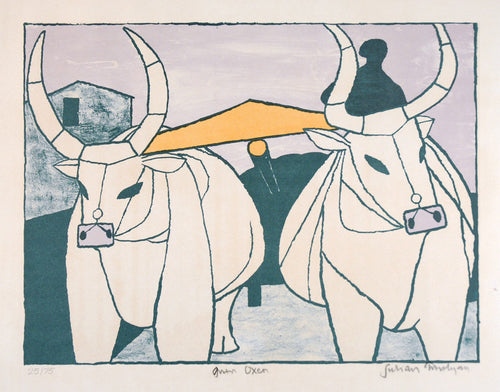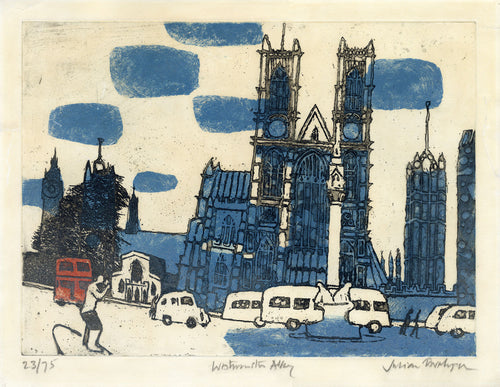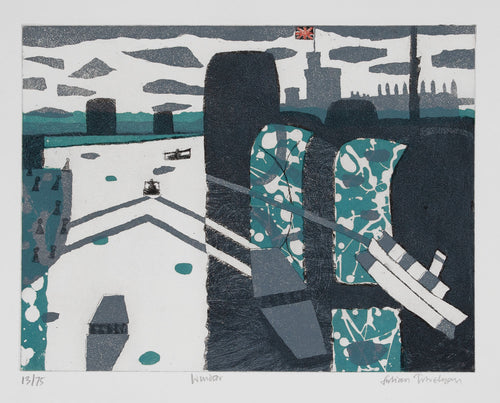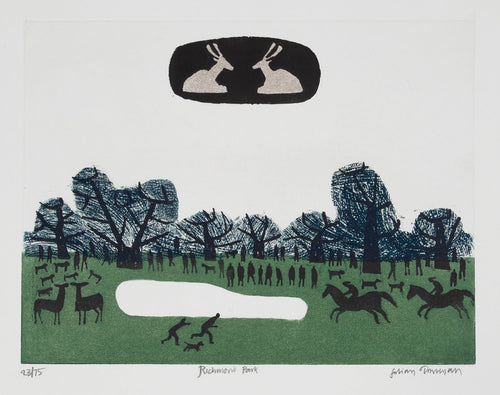An artist and printmaker with a keen eye for graphic invention, Julian Trevelyan was a major unsung figure behind the British etching revolution of the 1960s. A Surrealist in his youth, the magic of dreams and the subconscious never truly left his work. In his later prints of ostensibly ordinary, mundane scenes or rural and industrial landscapes can be found a powerful imagination that frequently transformed the everyday into the other-worldly.
 (left) portrait of Julian Trevelyan; (right) 'Holy Ganges'
(left) portrait of Julian Trevelyan; (right) 'Holy Ganges'
Born in 1910, Trevelyan began life in an academic family; his father was a classical scholar and poet, his uncle a historian, and his grandfather a writer and Liberal politician who had been knighted for his civil service. Unsurprisingly, Trevelyan showed equal promise as a young man and was admitted to Trinity College, Cambridge to read English Literature, where under the tutelage of Wittgenstein he first encountered the dream theories of Surrealism.
 'Runway'
'Runway'
Initially experimenting with his own art after being exposed to the work of contemporary French Surrealist painters, Trevelyan exhibited his first work with the London Group in 1929 before leaving Cambridge for the bohemian streets of Paris, renting an apartment in Montparnasse with the thought of becoming a full-time artist.
 'Duomo'
'Duomo'
Despite early success, it wasn’t until 1931 when he joined Stanley Hayter’s famous print workshop Atelier 17 (a name Trevelyan provided later in 1933) in Montparnasse that he received any formal training. Under the guidance of Hayter, Trevelyan developed a keen understanding for printmaking, and especially for etching. Hayter's atelier provided a heady environment for a young up-and-comer: colourful artists came and went as graphic innovation and experimentation was constantly underway. The etching processes Trevelyan was shown were entirely alien to him, and radically different from any work that had been done before in the medium. The skills he acquired from Hayter and his assistants would underpin a lifetime dedicated to ink and the acid bath.
 'Aigues Mortes'
'Aigues Mortes'
The atelier also offered Trevelyan acquaintances with a host of extraordinary artists working in printmaking at the time. During this period he was introduced to the abstract artist Alexander Calder (who rented the house next door) and fellow etcher Anthony Gross as well as working alongside the great figures of Ernst, Kokoschka, Miró, Masson, and Picasso. Though Trevelyan’s work was still experimental, with their influence and expertise he began to develop his own unique style, incorporating everyday objects and scenes in his prints and portraying them with an unusual childlike quality.
 lithograph of St Catherine's College, Cambridge
lithograph of St Catherine's College, Cambridge
In early 1934 Trevelyan returned to England, though he continued to rely on technical advice from Hayter through correspondence. A year later he had set up his etching studio at Durham Wharf in Hammersmith, where he remained until his death in 1988. At home in his own studios, he trialled and developed new methods of etching, especially in the use of bright colour, whilst also producing occasional lithographs and continuing to draw and paint.
Though still utterly involved with the printing processes he had learnt in Paris, by 1938 Surrealism had run its course and Trevelyan felt moved to resign from the English branch of the movement. With the outbreak of the Second World War, he reunited with Hayter once again as part of the Industrial Camouflage Research Unit, putting the printmaker's eye for detail and precision to work in designing and applying camouflage patterns.

 (above) 'Lions'; (below) 'Ankole Cattle'
(above) 'Lions'; (below) 'Ankole Cattle'
In 1942 Trevelyan was posted to Africa and the Middle east to research desert camouflage; though severe depression after his return would see him invalided on the recommendation of a psychiatric officer, time spent travelling in the exotic surroundings of Cairo and Lagos would later influence much of his work, in which the landscapes and wildlife of India and the African plains would feature heavily.
 'Palazzo Pitti'
'Palazzo Pitti'
After the war from 1955-63 Trevelyan worked at the Royal College of Art, where he was made Head of the Etching Department. With immense enthusiasm for his work and the desire to share his knowledge with others as Hayter had done with him, Trevelyan became a hugely influential teacher. Today he is considered by many to have been one of the major driving forces behind the etching revolution in the art schools of the 1960s and his numerous innovations spurred on notable students to produce work in the medium, including the young David Hockney, R. B. Kitaj, and Norman Ackroyd, arguably its foremost users in the latter half of the 20th century.
 'Amsterdam'
'Amsterdam'
Trevelyan's own etching work in this later period of his life is characterised by combinations of simple forms and bold uses of colour, something that had been previously lacking in the genre where the greys, browns, and sepia tones of traditional aquatint had previously been king. While his later works were often more representational, depicting harbour scenes, streets and architectural monuments, or figures at work and moving through landscapes, their simple and stylised depiction lends them a magical air that harks back to his surreal and abstract compositions of the early 1930s.
 'Benares'
'Benares'
In 1963, after suffering a sudden brain infection, Trevelyan lost nearly all his capacity for speech and retired from his teaching post. After several courses of speech-therapy, he made a swift recovery and turned once more to printmaking. Though no longer part of the Royal College staff, he sustained his love of education through the publication in the same year of his book Etching: Modern Methods of Intaglio Printmaking, now regarded as a key text for students of modern printmaking and graphics.
 'Outside Kampala'
'Outside Kampala'
A founding member of the Printmakers' council in London, a later fellow of the Royal College and Academician at the Royal Academy of Arts, Trevelyan died in 1988, leaving behind him an enormous legacy in the world of art education and a remarkable body of graphic work constituting around 400 individual prints. An artist of consummate skill and power, his work is worthy of a reevaluation.
